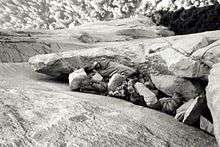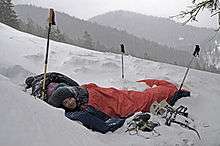Bivouac shelter

A bivouac shelter is any of a variety of improvised camp site or shelter that is usually of a temporary nature, used especially by soldiers, persons engaged in scouting and mountain climbing.[1] It may often refer to sleeping in the open with a bivouac sack, but it may also refer to a shelter constructed of natural materials like a structure of branches to form a frame, which is then covered with leaves, ferns, and similar material for waterproofing and duff (leaf litter) for insulation. Modern bivouacs often involve the use of one or two man tents, but may also be without tents or full cover.[2] In modern mountaineering the nature of the bivouac shelter will depend on the level of preparedness; in particular whether existing camping and outdoor gear may be incorporated into the shelter.[3] A bivouac shelter is colloquially known as a bivy, bivvy, or bivi.
The word bivouac is French and ultimately derives from an 18th-century Swiss German usage of beiwacht (bei by, wacht watch or patrol).[2] It referred to an additional watch that would be maintained by a military or civilian force to increase vigilance at an encampment.[2] Following use by the troops of the British Empire the term became also known as bivvy for short.[2]
Construction

Single-sided designs allow easy access and allow the heat of a fire into the shelters, while full roofed designs have much better heat retention. As a general rule the roof should be at least a foot thick and opaque to bright sunlight. Artificial bivouacs can be constructed using a variety of available materials from corrugated iron sheeting or plywood, to groundsheets or a purpose-made basha. Although these have the advantage of being speedy to erect and resource efficient they have relatively poor insulation properties.
There are many different ways to put up a bivouac shelter. The most common method is to use one bivouac sheet as the roof of the shelter and a second as the groundsheet. The 'roof' flysheet is suspended along in its ridge line by a cord tied between two trees which are a suitable distance apart. The four corners of the flysheet are then either pegged out or tied down to other trees. Care must be taken to leave a gap between the ground and the sheet to ensure that there is enough air flow to stop condensation.
A basha is a simple tent, made from one or two sheets of waterproof fabric and some strong cord. Generally a basha is made of reinforced nylon with eyelets and loops or tabs located along all four sides of the sheet and sometimes across the two central lines of symmetry. The basha is an extremely versatile shelter that can be erected in many different ways to suit the particular conditions of the location. (The word also sometimes refers to a special type of bivouac sack (see below).
Bivouac sack

A bivouac sack is a smaller type of bivouac shelter. Generally it is a portable, lightweight, waterproof shelter, and an alternative to larger bivouac shelters. The main benefit of a bivouac sack shelter is speed of setup and ability to use in a tiny space as compared to tent-like shelters. A bivouac sack is therefore a common choice for hikers or climbers who have to camp in tight areas, or in unknown areas. A bivouac sack will usually have a thin waterproof fabric shell that is designed to slip over a sleeping bag, providing an additional 5 to 10 °C of insulation and forming an effective barrier against wind chill and rain.[4] A drawback of a simple bivy sack is the humidity that condenses on the inner side, leaving the occupant or the sleeping bag moist. Moisture severely decreases the insulating effect of sleeping bags.[5] This problem has been alleviated somewhat in recent years with the advent of more waterproof/breathable fabrics, such as Gore-Tex, which allow some humidity to pass through the fabric while blocking most external water. A traditional bivy bag typically cinches all the way down to the user's face, leaving only a small hole to breathe or look through. Some modern fabrics are sufficiently gas-permeable that they can be safely zipped up around the user's head in order to shut out the elements completely.
Boofen
In the German region of Saxon Switzerland in the Elbe Sandstone Mountains climbers refer to overnighting in the open air as Boofen (pronounced "bo-fen"). The spot selected for overnight stays usually comprises an overhang in the sandstone rock or a cave, the so-called Boofe ("bo-fe"). This has often been adapted with a sleeping area and fireplace. In the national park itself, Boofen is only permitted at designated sites and only in connection with climbing, although in this case lighting fires is absolutely forbidden. The colloquial Saxon word boofen was derived from pofen (= sleep soundly and for a long time).
Examples
An example of a bivouac being made in a time of urgency was shown when the climber Hermann Buhl made his ascent of Nanga Parbat in 1953 and was forced to bivouac alone on a rock ledge at 8000m altitude, in order to survive until the following morning.[6]
See also
References
- ↑ "Bivouac". Oxford English Dictionary. Retrieved 13 December 2016.
- 1 2 3 4 James Bradford (2004). International Encyclopedia of Military History. Routledge.
- ↑ Mark Houston (2004). Alpine Climbing: Techniques to Take You Higher. The Mountaineers Books.
- ↑ Howe, Steve; Dave Getchell (March 1995). "Hit the sack". Backpacker. 23 (139). pp. 143–169. ISSN 0277-867X. Retrieved 2013-06-21.
- ↑ Camenzind, M., M. Weder, and E. Den Hartog. Influence of Body Moisture on the thermal insulation of sleeping bags, Symposium on “Blowing Hot and Cold: Protecting Against Climatic Extremes”. Dresden, NATO RTO-MP-076 2001; KN4-1-KN4-15
- ↑ "9 Legendary Bivoacs". Adventure Journal. Retrieved 13 December 2016.
.svg.png)